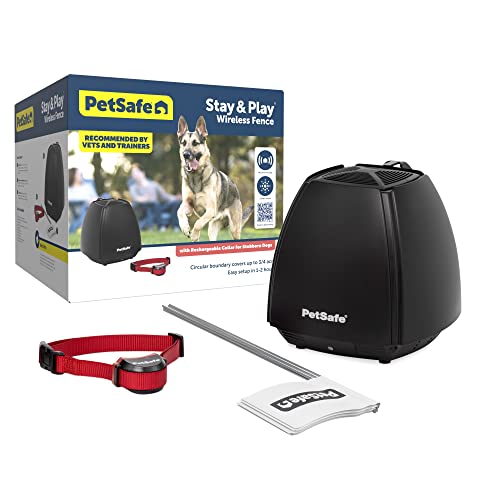If you’re looking for a simple solution to contain your canine escape artist or stop your dog from digging up your garden, you’re probably in the market for a wireless dog fence. There are hundreds of wireless fence options available, so it’s important to focus on key buying considerations, like the most important features, the main differences between each product, and which is the best wireless dog fence for you and your dog.
Our vet advisor, Dr. Chyrle Bonk, DVM, reviewed dozens of wireless dog fences and she chose the PetSafe Wireless Containment System as her top pick. With its waterproof, wireless dog collars and combined wired and wireless technology, this wireless dog fence is one you can trust to keep your pups contained. Read how she chose the top 5
In addition to a wireless dog fence, you should also look into investing in electronic dog doors. Dog doors are an easy way for your dog to safely go outdoors and come back inside on their own.
Our Vet’s Top 5 Wireless Dog Fences
Here are the top picks from our veterinarian. Compare the ratings and features of the different models.
| Vet’s Picks | Model | Rating | Range | Adjustable Boundaries | Expandable to Multiple Dogs | Expandable Perimeter (w/Additional Purchase) |
|---|---|---|---|---|---|---|
| Best Overall | PetSafe Wireless Fence Pet Containment System | Up to 10 acres | ||||
| Best Budget Buy | JUSTPET Wireless Fence Dog Boundary Container & Collar | 1,000 feet | ||||
| Best for Small Dogs | PetSafe Elite Little Dog In-Ground Fence | 1/3 acre | ||||
| Best Above-Ground | PetSafe Stay and Play Wireless Fence for Stubborn Dogs | 3/4 acre | ||||
| Best Underground | SportDOG Brand In-Ground Fence Systems | Up to 1.33 acres |
*Ratings are on a scale of 1 to 5 and based on reviews, feedback, and opinions of actual customers
Who Should Buy a Wireless Dog Fence
- People who don’t want a visible fence – Because it’s hidden, a wireless fence is a great alternative for people who don’t like the look of a traditional fence or for anyone who doesn’t want to obscure the look of their yard.
- Dog owners with large yards – If you have a large yard, a wireless dog fence is a much more cost-effective option than traditional fencing, which can cost upwards of $4,000.
- New puppy parents – A wireless dog fence is also useful when training a new puppy (or when moving with an older dog to teach them the boundaries in your new yard) so they don’t take off while they’re out learning to do their business.
Who Should Not Buy a Wireless Dog Fence
- Pet owners looking to prevent intruders – A wireless fence will not protect your dogs from predators or intruding animals. For that, you should install a traditional fence.
- Pet owners who also want to contain children – It’s also not a wise option to contain or protect your children.
- Homeowners looking for privacy – If you’re looking for privacy as well as security, standard, above-ground fencing makes more sense.
Research Tips (From a Veterinarian)
As a veterinarian, I often get asked how to choose a good dog wireless dog fence or what types of fencing systems to consider. Here are some tips and best practices to consider when purchasing a wireless dog fence.
- Type of fence – In-ground fences involve burying a wire around the perimeter, while above ground fences give your pup a designated circular permissible area. Both types use a collar that communicates with either the buried wire or a receiver to send sound, vibration, or static shock signals to your dog if they cross the boundary. In-ground fences require time and labor to install, while above ground fences are ready to use almost immediately. In-ground fences have a set perimeter, while above-ground fences may have some slight variation in the distance that your pup can go because it’s based more on a spatial measurement than a set boundary.
- Check your perimeter – Make sure you measure your yard to determine the desired fence perimeter for your dog. The size of your yard can impact which type of fence you buy. Some can’t be customized. Most wireless fence systems cover an area of 1/3 to 1/2 acre, which will work well for most urban yards. Some will span up to 100 acres with the purchase of additional wire.
- Safety and adjustability – When you’re dealing with electricity and your dog, you want it to be safe! Look for a waterproof collar so that it can be used even on rainy days, and check to see that the collar won’t shock your dog for returning to the designated area. You’ll also want something that is highly adjustable to accommodate more sensitive dogs. You should also look for a system that provides a sound and vibration warning before the static shock so that your dog has a chance to obey his boundaries before feeling it.
- Containing or repelling – You’ll want to consider what you want from a wireless fence for your dog. Obviously, you want to keep him in the yard and on your property. But if you want to protect your garden, you’ll need to set your containment into zones to repel him from those areas. You can even find transmitters that will emit an area of effect that is entirely an off-limits zone. You can place that in your garden, for example, and when your pup enters the area, it will set off his deterrent.
- Training and containment – To go hand-in-hand with a good range, you may want to find a system that will take care of training your pup as well as containing him. You can find a behavior e-collar that will correspond with your containment transmitter; one collar for both the fence and the handheld remote that you can use to manually issue discouragements for bad behavior.
- Number of dogs – If you have multiple furry friends, make sure they’re all properly outfitted for their new outdoor play area by getting a system that can handle multiple dogs. In many cases, you can purchase additional collars, but you’ll want to make sure your system has the capability to handle more than one collar.
- Portability – If your dog is on-the-go, an above-ground system might be more suitable since you can pack it up with you and deploy it anywhere you go – no digging required. However, if your pup prefers the comforts of home, a more permanent in-ground system may be your best bet.
- Maintenance and warranty – In-ground systems may need to be periodically checked to confirm they’re functioning properly. Above ground systems may experience transmission problems. Look for a system with a long warranty (2+ years) in order to help you through any problems that may occur.
How Much Do They Cost?
Between $100 and $400
As a general rule, you can expect to pay between $100 and $400 for a wireless dog fence. Generally speaking, the biggest factor that influences price is the range of the perimeter and number of collars you need. If you have multiple dogs and a large yard, you’ll be looking at spending well over $300 for your setup, while those with a smaller yard and a single pet can manage to stick close to the $100 mark.
Our Methodology: Why Trust Pango Pets
When choosing my top five picks for wireless dog fences, I considered ease of use, safety, size of the contained area, number of dogs accommodated, and the wireless fence systems’ adjustability. I chose these wireless dog fences as the best in their category because they can contain a relatively large area using three or more methods of reinforcement. They all offer flags or wires for training purposes, as well, making it easier to teach your dog how to stay on your property or within the boundaries of a safe zone that you define. – Dr. Chyrle Bonk, DVM
The Best Wireless Dog Fences: Full Reviews
If your dog craves the freedom to run while you wish for peace of mind, you’ll love the PetSafe Wireless Containment System. Like other systems, this fence combines wire with wireless technology: bury the heavy-duty wire, install the transmitter, and control your pets via the waterproof, wireless collars. The result is a stronger signal than all-wireless dog fences, which translates to increased safety, especially with stubborn runners.
You can purchase more dog collars with this system, allowing you to add up to five dog collars to your initial purchase and transition your whole pack in a painless one-step process. You can even expand with more dogs and add more fence to cover up to 25 acres. These expansions make the possibilities almost limitless, even for the free-range type of puppy parent. Depending on how many collars and how many acres you plan to cover, this system can set you back anywhere from $250 to $800, making this a substantial investment.
- Proudly Made in the USA
- Expandable up to an unlimited number of dogs
- Up to 10 acres of coverage
- Reviewers note some durability issues
- Boundary lines can be inconsistent
The JUSTPET Wireless Fence Dog Boundary Container & Collar will allow you to keep your dog safe and train him as well by pressing the function switch key that will change the mode of the collar. The compact base station serves as a remote and as the center of a 330 yard (or 1,000 feet) perimeter range.
You’ll easily be able to switch from a sound deterrent to vibration and to a static shock that will allow you to work the collar as a training collar or a perimeter zone – or a combination of all three. You’ll also appreciate the two different-sized conductive nodes for customizing your dog’s collar to his breed and size. For example, a large dog with a thick coat will need longer nodes.
- 1,000 ft range
- Rated IP65 waterproof
- Adjustable boundary and collar
- Inconsistent correction
- Not ideal for small or oddly shaped yards
PetSafe Elite Little Dog In-Ground Fence includes an adjustable collar that is waterproof, so you won’t need to worry about rain or if your dog is prone to puddle-jumping. There are four levels of static stimulation to make sure your pet stays in his or her safe zone, and that will be 1/3 an acre surrounding the base station. However, you can expand it up to 25 acres with additional wire and flags, should you choose. You’ll also appreciate that option if you have multiple dogs – and you can add countless collars to this system.
A low battery indicator will keep you from wondering whether the battery is sufficient, and that means you’ll be preventing an inaccurate or inconsistent correction from the collar. (And your dog will certainly thank you for that!)
- Designed for dogs 5 lbs and up
- Covers 1/3 acre range
- Reflective collar straps
- May malfunction after a few months
- Unreliable correction
The PetSafe Stay and Play Wireless Fence for Stubborn Dogs is made with your stubborn dog in mind but will work for just about any pup. There are few things more frustrating than trying to train a strong-willed dog, but this no-wire fence system can definitely make the job easier. The adjustable collar is specially designed for hard-to-train dogs, incorporating static warnings to aid in training and use. The adjustable, waterproof collar fits pets with neck sizes 6 to 28 inches and offers five levels of adjustable correction.
With your purchase, you’ll get all you need to set a safe space for your stubborn dog: the base transmitter, a waterproof and adjustable collar with 50 training flags, an operating guide, test light tool, contact point wrench, and mounting bracket hardware. It’s backed by a one-year warranty.
- Portable; no need to bury wire
- 3/4 acre coverage
- No correction for re-entering boundary
- Snap collar comes off easily
- Inconsistent boundary lines
As a top-rated hybrid system, the SportDOG Brand In-Ground Fence System blends buried wire with wireless receiver collars to build a highly expandable, highly customizable containment system. You’ll need to bury your wire, but the trade-off is flexibility: you can create a custom-shaped fence up to 100 acres in size. You’ll also appreciate the built-in lightning protection, wire-break alarm, and anti-linger feature.
When purchasing this containment system, you can also pick up the corresponding training remote. If you do choose to use it, you can vary the discouragement with your choice of vibration, tone, and shock. These training tools can be controlled by remote with a range of intensity from one to seven on both the shock and vibration modes.
- Included coverage area up to 1.33 acres
- Expandable up to 100 acres
- Four levels of correction + vibration-only
- Additional collars available for multiple dogs
- May shock when set to alert/vibrate
- Some dogs don’t respond to the correction
Frequently Asked Questions
What is a wireless dog fence and how does it work?
The collar will respond to the barrier when it crosses, setting off a discouragement to urge your dog back into his safe zones. Those discouragements are generally a gentle static shock, a beep, a vibration, or some combination of the three. You may be able to choose which is used if they have a variable mode, or you can choose a system that has the correction options you prefer.
What’s the difference between a wireless dog fence and a hybrid or semi-wireless dog fence?
Are wireless dog fences effective?
Are wireless dog fences safe?






















